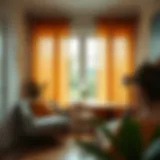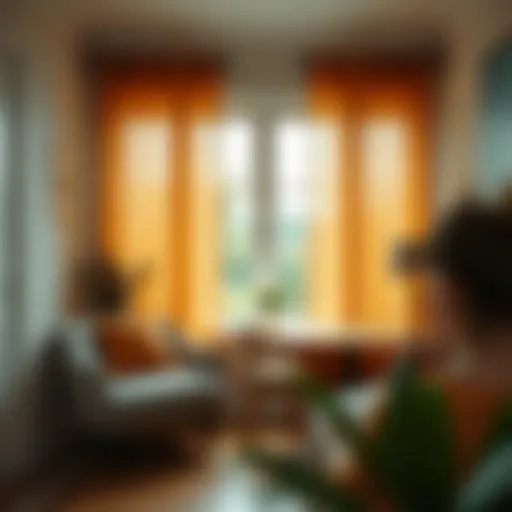Soft Frame Designs: A Modern Furniture Perspective
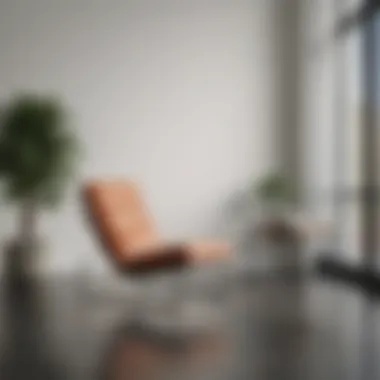

Intro
Soft frame designs in modern furniture bring a breath of fresh air into the realm of interior aesthetics. They are not merely about comfort, but rather an interplay of style, innovative materials, and functional spaces. To grasp the full potential of these designs, one must consider the historical context, the evolution of materials, and their practical applications in contemporary living areas. This exploration intends to illuminate the unique qualities of soft frames, guiding readers—whether homeowners, renters, designers, or DIY enthusiasts—through the visually appealing and functional landscape of modern furniture.
In essence, soft frames meld plush comfort with eye-catching style. They stand out in today’s market, offering not only a sense of relaxation but also significant versatility in design. This article will delve into current furniture trends, ingenuity in DIY projects, and provide a thorough understanding of how to effectively incorporate soft frame designs into any living space.
Furniture Trends
Current Market Trends
Amid the fast-paced world of interior design, soft frames are emerging as a staple that reflects the modern inclination towards called warmth and coziness. With the growing interest in mental health and well-being, consumers are increasingly drawn to furniture that evinces comfort. Here are some notable trends:
- Natural Materials: Furniture makers are gravitating towards organic fabrics, like linen and cotton, coupled with wooden or metal frames that feel less rigid.
- Sustainability: Eco-friendly materials are shaping the way soft frames are constructed, with manufacturers seeking options that are both stylish and kind to the planet.
- Functionality: Furniture that adapts to multifunctional spaces is a key focus, as more folks juggle work-from-home setups and casual living areas.
Popular Styles and Designs
As you browse through furniture stores or online retailers, you will notice a slew of captivating soft frame styles, each with unique characteristics:
- Curved Sofas: These pieces are making waves for their inviting shapes that create a sense of fluidity in a room.
- Modular Seating: Offering flexibility, modular designs allow users to reconfigure layouts, catering to changing moods or gatherings.
- Accent Chairs: With their playful colors and textures, soft frame accent chairs lend personality to any nook.
"Soft frames provide an opportunity to blend aesthetics with comfort, appealing to the sensibilities of modern dwellers."
DIY Projects
If you're one who revels in adding a personal touch to home decor, soft frame furniture provides a fantastic playground for creative DIY projects.
Step-by-Step Guides
For the hands-on types looking to create their own soft frame pieces, consider these outlines:
- Reupholstering an Old Chair:
- Building a Soft Frame Side Table:
- Choose a durable fabric that resonates with your decor.
- Take off the old upholstery carefully.
- Cut and sew the new fabric, then reattach to the frame.
- Use a small piece of plywood for the top.
- Attach soft foam padding to the edges for a rounded look.
- Cover it with fabric for the soft frame finish.
Budget-Friendly Ideas
Transforming your space on a budget doesn’t have to be a daunting task. Keep these tips in mind:
- Thrift stores can sometimes yield hidden gems that just need a little love.
- Look for fabric remnants when reupholstering, as they can significantly reduce costs.
- Opt for DIY over ready-made options to save a pretty penny while customizing your items.
In navigating the world of soft frame designs, you’ll find they aren’t just about being laid back; they are a statement of style and comfort, harmonizing beautifully with modern living. Whether you're seeking elegance, functionality, or a touch of personality in your home, soft frame designs provide an appealing avenue to achieve that vision.
Prolusion to Soft Frame Designs
Soft frame designs move beyond the conventional hard lines typically associated with furniture. They have become a significant trend in modern décor, reflecting a shift toward more human-centered and inviting spaces. With an emphasis on comfort without sacrificing style, this design approach captures the essence of flexibility and adaptability that contemporary living demands.
Understanding soft frame designs is essential for homeowners, renters, and designers alike, as they present opportunities to create inviting atmospheres. This article sets out to explore the nuances of soft frame designs, from materials to real-world applications, highlighting their benefits and inevitable considerations.
Defining Soft Frame Designs
Soft frame designs essentially refer to furniture frameworks that prioritize comfort through softer, rounded edges and plush constructions. Unlike traditional furniture, which often emphasizes sharp angles and rigid lines, soft frame designs incorporate curvilinear forms and cushioned elements, giving them a more approachable appearance.
For instance, consider a loveseat with enveloping arms that welcome a person to sink into the seat. This is an ideal embodiment of a soft frame—a structure designed as much for relaxation as for aesthetics. Soft frames are not confined to sofas alone; they appear in items like bean bags, plush chairs, or uniquely shaped ottomans designed with a focus on both comfort and creativity.
Historical Context and Evolution
Soft frame designs have not emerged in a vacuum. Understanding their evolution means looking into cultural shifts in design philosophy. In the late 20th century, furniture designers began to challenge the status quo of hard surfaces and geometric shapes. Influences from Scandinavian minimalism emphasized functionality, leading to a demand for pieces that meld comfort with utility.
In the 1980s and 1990s, the rise of Postmodernism brought a playful approach to design. It flipped the script, encouraging designers to redefine how furniture interacted with human form and space. These shifts paved the way for the emergence of soft frame designs as we understand them today.
Ultimately, today's soft frame designs reflect a greater awareness of how our environments impact our well-being. As the lines between personal and public spaces continue to blur, soft frame furniture encourages connection and comfort, making their presence essential in modern interior design.
Key Characteristics of Soft Frame Designs
When it comes to soft frame designs, there is so much more than meets the eye. These characteristics not only shape the visual identity of modern furniture but also determine their functionality and appeal. Understanding these elements is essential for anyone looking to invest in or incorporate soft frame designs into their spaces. Let's take a closer look at a few key characteristics that stand out remarkably in this genre of furniture design.
Material Selection
The selection of materials is at the core of soft frame designs, as they significantly influence both aesthetics and durability. Choosing the right fabric, wood type, or eco-friendly option can make or break the vibe of your furniture.
Fabric choices
Fabric is often what makes or breaks the comfort level of soft frame furniture. Soft, plush materials like velvet or boucle are popular choices, infusing the pieces with warmth and coziness. These fabrics not only look inviting but also enhance the tactile experience when interacting with the furniture. They provide a comforting feel, inviting you to sink into a chair or lounge on a soft sofa after a long day.
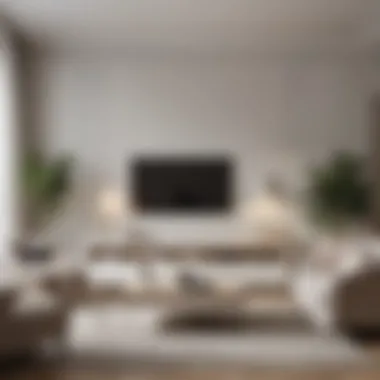

However, fabric choice can come with trade-offs. While luxury fabrics offer a plush feel and aesthetic appeal, they may require more maintenance and care to keep them looking pristine. Stains and wear can be a concern. So, opting for durable fabrics that balance comfort and resilience can be a smart move.
Wood types
Accompanying the fabric choices, the selection of wood types plays a crucial role in establishing the framework of soft frame designs. Popular woods like oak and walnut provide a strong backbone while also lending a touch of elegance. The natural grain and texture add depth to the overall design, making pieces unique.
One can’t overlook the charm of reclaimed wood, which is gaining traction. It provides a rustic touch and ensures a story behind each piece, reflecting values of sustainability. However, certain wood types could be heavy, which can pose challenges regarding mobility and placement. The weightiness might not work well for all spaces, especially smaller apartments where flexibility is vital.
Eco-friendly materials
With increasing awareness of environmental issues, eco-friendly materials have become a desirable aspect of soft frame designs. Materials like bamboo or recycled plastics are gaining prominence. Their use speaks not only to a commitment to sustainability but also to a contemporary design ethos.
These materials often thrive on being lightweight yet durable, aligning with trends that favor minimalism and efficiency. The downside might be limited design options compared to traditional materials, affecting the visual preferences of some. Still, for eco-conscious homeowners and designers, the advantages typically outweigh the drawbacks, promoting a healthier planet alongside stylish interiors.
Design Aesthetics
Design aesthetics in soft frame designs lean heavily into the idea of fluidity and organic shapes. This characteristic fosters a welcoming atmosphere while providing functionality that adapts to various spaces.
Simplicity vs. Complexity
In the realm of design aesthetics, there lies a constant tension between simplicity and complexity. On one hand, simple, clean lines contribute to an uncluttered look, making spaces feel open and airy. This minimalism often resonates with those who favor a contemporary style and functionality over embellishment.
On the other hand, complex designs can introduce an artistic flair and may showcase craftsmanship in intricate details. Finding balance is key; too much complexity can overwhelm a space, while sheer simplicity might come off as bland. The beauty lies in selecting what resonates with the feel you want to achieve in your home.
Color palettes
Color palettes can completely alter the perception of furniture within a space. Soft, muted tones like pastels can create an inviting and soothing atmosphere. In contrast, bolder, deeper colors can serve as striking focal points, bringing a sense of drama or warmth.
Choosing the right color palette allows homeowners to weave their personality into their living spaces. One advantage of soft frame designs is their potential to easily adapt across various color themes. However, the choice of palette should align with the rest of the decor to avoid clashes, which could distract or disrupt the harmony of the space.
Textures and finishes
Textures and finishes add a vital tactile element to soft frame designs. Combining various textures can inject depth and interest into a room. For example, pairing a soft velvet sofa with rustic wooden accent pieces can create an engaging contrast that tantalizes the senses.
The finish applied can also determine the durability and maintenance level of soft frame furniture. Matte finishes often offer a more contemporary look and tend to disguise fingerprints and smudges better than high-gloss options, which can emphasize imperfections but add a touch of elegance. Evaluating the final finish is important, as it ultimately impacts not just the aesthetics but the long-term upkeep as well.
"Choosing the right characteristics in soft frame designs can enhance your living space's comfort and aesthetic appeal, transforming houses into homes."
Engagement with these key characteristics will lead to making informed decisions in implementing soft frame designs into various living spaces, proving that these designs are as much about experience and emotion as they are about looks.
Applications of Soft Frame Designs in Different Spaces
The significance of soft frame designs extends beyond aesthetics, permeating multiple areas of our daily lives. These designs are not just for show but serve a functional role in various environments. Whether in a cozy living room, a restful bedroom, or a productive office, soft frame furniture elements can enhance both comfort and visual appeal. In this section, we will explore the versatile applications of soft frame designs, highlighting their advantages, considerations, and specific elements that make them so impactful.
Living Room Integration
The living room is often the heart of the home, a place where family and friends gather. Furnishing this space with soft frame designs not only adds warmth but also creates a welcoming atmosphere.
Seating solutions
Seating solutions in soft frame designs prioritize comfort while emphasizing an inviting aesthetic. A key characteristic of these designs is their use of plush materials that cradle the body, promoting relaxation during gatherings. Unique features, like oversized sofas or soft armchairs with gentle curves, contribute to a cozy environment, making them a popular choice among homeowners.
However, it’s crucial to consider the balance of style and functional capacity. Soft frame seating can sometimes lack the rigidity needed for long-term support, which might be a downside for users preferring firm seating.
Accent pieces
Accent pieces, such as soft ottomans or oversized cushions, play a crucial role in the overall ambiance of the living room. These items often embody the playful aspect of soft frame designs, allowing for personal expression through pattern and texture choices. Their versatility is a significant asset; they can function as additional seating or simply as a decorative element to enhance the design.
Yet, it’s essential to be mindful of their placement. An excess of soft furnishings can lead to a cluttered look, detracting from the desired fluidity and simplicity of soft frame design philosophy.
Modular arrangements
Particularly appealing in contemporary settings, modular arrangements allow for customization that adapts to changing lifestyles. A prominent aspect of modular soft frame designs is their flexibility; you can arrange them in various configurations, catering to both intimate family moments or large gatherings. Their unique modular characteristics enable homeowners to express individual taste while ensuring functionality.
However, one must consider the potential downsides – such as the challenge of finding pieces that seamlessly integrate together if purchased separately. Ensuring cohesion in design is key, lest the final arrangement seem disjointed or jarring.
Bedroom Comfort
The bedroom should be a sanctuary, and soft frame designs can significantly enhance comfort in this space.
Bed frames
When we talk about bed frames, soft frame designs often feature padded headboards or beds that emphasize plush surfaces. This design choice is favored for its comfort during those lazy mornings or quiet evenings with a good book. The luxurious feel of a soft frame bed can create a greater sense of coziness, allowing users to unwind fully.
It becomes crucial to evaluate the support mechanism as some soft frames may not provide the necessary firmness for well-aligned sleep. That said, incorporating softer frames might be ideal for individuals preferring a cushioned feel while sleeping.
Nightstands


Soft frame nightstands with rounded edges complement the overall design of the bedroom, steering clear of sharp lines that can interrupt the calming ambiance. These style elements can add to the serene environment, bringing functionality without compromising aesthetic appeal.
Yet, in their pursuit of beauty, some might sacrifice practicality; too much softness can sometimes lead to limited storage options compared to more solid, structured designs. Knowing this, homeowners should balance style and storage needs carefully.
Dressers
Dressers in soft frame designs often embody graceful lines and subtle curves that not only add elegance but also keep the room feeling open. This can be especially striking in smaller bedrooms, where minimizing visual clutter is essential. They typically offer a tranquil and inviting presence, which is critical in creating a soothing atmosphere.
On the other hand, these designs might utilize softer materials that can wear faster. It's worth considering, as maintaining a pristine appearance becomes more challenging over time.
Office Settings
Soft frames are not just for relaxation; they have practical applications in office settings, blending form with function perfectly.
Desk designs
Soft frame desks have emerged as stylish alternatives to traditional office furniture. Unlike their rigid counterparts, these desks often incorporate rounded edges and softer materials, making them visually appealing without sacrificing comfort. They can create a more approachable work environment, conducive to creativity and collaboration.
However, one potential downside is the lack of durability compared to more robust designs, which may erode over time under heavier use.
Storage options
Soft frame storage options, such as fabric-covered cabinets or cushioned bins, bring a sense of warmth to often sterile work environments. Their ability to soften the ambiance contributes to a more pleasant work experience, making them increasingly favored by many modern professionals.
Yet, buyers should acknowledge that while appealing, such soft solutions may lack the strength or capacity of traditional wooden storage, meaning careful selection based on needs is vital.
Collaborative spaces
In collaborative office settings, soft frame furniture facilitates interaction, supporting a more relaxed and open atmosphere for teamwork. Elements like plush dividers or lounge-style seating arrangements can create inviting areas for brainstorming sessions and casual discussions. This characteristic is a standout feature, fostering communication and collaboration among teams.
Conversely, dependence on soft furnishings might detract from professionalism in certain environments, making it crucial for organizations to align choices with their brand identity.
The strategic use of soft frame designs in various spaces can elevate both functionality and aesthetic value, making homes and workplaces more inviting.
Each application of soft frame designs draws distinct benefits, while also presenting unique considerations for homeowners, designers, and renters alike. The integration of these versatile designs is more than just trend; it’s an intentional choice towards creating spaces that reflect comfort, style, and functionality.
Trends Influencing Soft Frame Designs
The world of furniture design is constantly evolving, and soft frame designs are increasingly finding their place in this dynamic landscape. Understanding the trends influencing these designs is crucial for homeowners, designers, and anyone interested in modern aesthetics. We're no longer just talking about how furniture looks; we’re considering how it interacts with our lifestyles, values, and the environment around us.
Sustainability in Design
Sourcing sustainable materials
When we chat about sustainability in furniture, what often comes to mind is the idea of sourcing sustainable materials. This practice is reshaping the footprint of the furniture industry. It involves using resources that are renewable, recyclable, and minimally harmful to the environment. Bamboo, for instance, has gained prominence due to its rapid growth and strength, making it a solid choice for soft frame designs.
The key characteristic of these materials is that they are collected with regard to environmental impact. As such, many manufacturers are opting for fabrics like organic cotton or recycled polyester, which further reinforce eco-conscious practices. This trend resonates greatly with consumers who are increasingly making purchasing decisions based on environmental responsibility.
One unique feature of sourcing sustainable materials is that it’s not just good for the environment; it can also enhance a piece's aesthetic appeal. Natural fibers bring a distinct feel and texture that synthetic materials might not replicate. However, it's vital to note that sourcing can sometimes escalate costs, as sustainable options might yield a higher price tag, depending on availability and production methods.
Repurposing and upcycling
In the same vein, repurposing and upcycling are two approaches taking center stage in soft frame design trends. These practices breathe new life into old materials or worn-out furniture. Imagine turning an unused wooden pallet into a minimalist coffee table, something that tells a story while being functional.
What's notable here is how trendy these methods have become. They signal a shift from a throwaway culture to one that values history and creativity. Key features of repurposing include originality and the celebration of imperfection, which can give a distinctive character to soft frame pieces. Yet, achieving that perfect look might require a bit of skill, and not everyone is up for a DIY challenge.
The advantages of repurposing are not only environmental but also economical. You can save a pretty penny while crafting something unique. On the flip side, DIY projects can become quite the undertaking and may not fit everyone’s style, especially if you prefer the clean lines of commercially available items.
Minimalist approaches
Minimalism has stepped into the spotlight as a fundamental approach influencing soft frame designs. This trend values simplicity, function, and a less is more philosophy. The soft-frame design aesthetic pairs wonderfully with this as it leans toward clean lines and uncluttered looks. The real draw of minimalist designs lies in their ability to create serene environments.
Key traits of minimalist approaches often include neutral color palettes and natural materials, which embody elegance without shouting for attention. A soft frame sofa in a muted tone can blend seamlessly into any room, creating a tranquil oasis. Such pieces foster a relaxed atmosphere that many people strive to curate in their homes.
However, going minimalist can sometimes pose a challenge for those accustomed to more elaborate decorations. The discussion of less also raises questions about functionality and comfort. It’s essential to strike a balance, ensuring there’s enough warmth and personality in the space without cluttering it up.
Technology and Soft Frames
Smart furniture solutions
As technology makes leaps and bounds, it’s nudging its way into the furniture industry, leading to the birth of smart furniture solutions. These innovative designs are not just aesthetically pleasing; they’re also intuitive. Think of a soft frame chair that adjusts to your posture or a table that charges your devices.
What sets smart furniture apart is its ability to incorporate convenience into daily life, appealing significantly to tech-savvy homeowners. However, it is important to weigh the benefit of convenience against higher price points and the potential for tech malfunctions. Not everyone is comfortable with the idea of their furniture needing an app to function.
Fluid designs
Fluid designs refer to the seamless transition between functionality and aesthetics, creating pieces that easily adapt to different environments. This characteristic makes soft frame designs particularly appealing for open-concept living spaces where flexibility is key. A soft frame sectional, for example, can be easily rearranged to accommodate gatherings or quiet evenings.
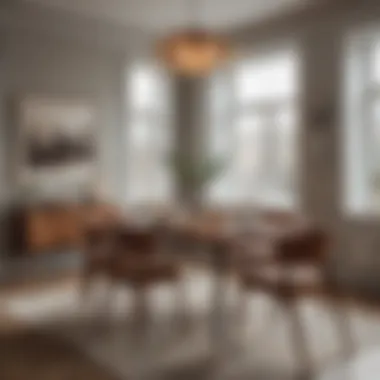

These designs tend to embrace versatility and comfort, often featuring soft curves that invite relaxation. However, maintaining a cohesive aesthetic when moving furniture around can be a challenge, especially if the surrounding decor isn't nearly as adaptable.
Customization through technology
In a world of ever-increasing personalization, customization through technology is becoming a major selling point for soft frame designs. Many manufacturers now offer options that allow consumers to choose fabrics, sizes, and configurations. This can transform a standard piece into something truly personal.
The hallmark of this trend is the level of engagement it offers consumers—your couch or chair can truly reflect your style and needs. Yet, while customization offers a unique advantage, it can also complicate the buying process, leading to a decision paralysis for some, as they are faced with an overwhelming number of options.
Benefits of Soft Frame Designs
When considering modern furniture, soft frame designs present a multitude of advantages. They encapsulate comfort, enhance aesthetics, and offer the flexibility that many contemporary homeowners crave. In the quest for a living space that is both functional and pleasing to the eye, these designs stand out. It’s not only about how a piece of furniture looks but also how it feels and interacts with its surrounding environment.
Enhanced Comfort
One of the most significant benefits of soft frame designs is their unparalleled comfort. This type of furniture tends to use plush materials and ergonomic shapes that invite relaxation. Take an overstuffed sofa, for instance. The soft frame allows for a supportive yet yielding surface to sink into after a long day.
Consider how such designs might transform your living space:
- Cushioned edges: The rounded corners reduce the harshness of a room, making it feel more welcoming.
- Supporting structures: Unlike rigid furniture, soft frames often have interiors that contour to the body, fostering better posture.
Homeowners can enjoy the sense of ease that soft furniture provides. Cuddling up with a good book or hosting a movie night becomes more inviting when the seating wraps you in comfort.
Visual Softness in Spaces
Soft frame furniture lends itself to creating a visually softer environment. Furniture with a delicate touch doesn’t just appeal to comfort but also to the eyes. Their gentle lines and inviting silhouettes can transform a space from stark to serene. With styles ranging from minimalistic to bohemian, soft frame designs help in establishing a special mood.
Imagine a sunny room with a light-colored, plush armchair paired with a soft knit throw. This evokes warmth and tranquility, a perfect retreat during a hectic day. Here's how they contribute to visual softness:
- Color plays a vital role: Soft hues such as pastels can enhance the peaceful nature of the room.
- Layered textures: Adding cushions and throws creates depth and a more inviting look.
Spaces adorned with soft frames invite interactions, encouraging relaxation and happy gatherings. They bring an element of flow into the overall design.
Versatility and Flexibility
In terms of versatility, soft frame designs shine brightly. These furniture pieces are suitable for a host of settings, adapting to different needs and aesthetic preferences. An open-plan living area may benefit from modular sofas that can be rearranged as needed, while a cozy reading nook might call for a single oversized chair.
- Adaptable layouts: Soft frame furniture often adapts well to various room layouts without overwhelming the space.
- Multifunctionality: Some designs serve more than one purpose, such as a sofa bed that can transform from a chic seating option during the day to a cozy sleeping area at night.
Drawing from a variety of styles allows homeowners to play around with their space’s look and feel. They can choose designs that fit with their current decor or become key pieces for a future renovation.
"Flexibility in design allows us to create environments that foster creativity and comfort in equal measure."
The wide array of benefits soft frame designs offer showcases their importance in modern furniture. Their comfort, visual appeal, and versatility make them a top choice for homeowners, renters, designers, and DIYers alike.
Challenges and Considerations in Soft Frame Design
When diving into the world of soft frame designs, there’s a delicate balance to strike between aesthetics and practicality. The challenges and considerations in soft frame design are pivotal not only for designers but also for homeowners and retailers. These factors play a crucial role in determining how well the furniture can adapt to wear and tear, how it fits into diverse budgets, and what maintenance routines are necessary to keep a soft frame piece looking fresh and appealing.
Durability and Maintenance
One of the essential elements to keep in mind with soft frame designs is durability. Unlike traditional furniture, which may consist of rigid materials, soft frames often incorporate textiles and softer structural elements. This can sometimes translate into a trade-off between comfort and long-lasting lifespan.
- Material Durability: Choosing the right fabric is critical. For example, performance fabrics, often found in brands like Sunbrella, are designed to withstand stains and fading, making them a wise choice for households with pets or children. Contrarily, more delicate textiles may require more careful handling and frequent cleaning.
- Care Requirements: Maintenance also varies significantly by design. Soft frame pieces that utilize removable covers, like those from IKEA’s modular sofas, allow for easier washing. In contrast, components that aren't easily accessible may become tedious to clean and sustain, thus requiring careful consideration from the outset.
Keeping furniture in top shape often requires specialized cleaning products or techniques. This aspect may factor into the buyer’s choices as well, affecting long-term satisfaction with any purchase.
Cost Implications
Cost is a significant consideration when exploring soft frames, influencing purchasing decisions across the board. There’s a wide range in price points, providing options for everyone from budget-conscious consumers to those looking for high-end luxury.
Budget-friendly options
When you consider budget-friendly options in soft frame designs, it's important to focus on balance—value without compromising too much on quality. For instance, many retailers offer modular furniture systems that enable flexibility without breaking the bank. Stores like Wayfair or Target are often keen on providing such offerings.
- Key characteristic: Affordability while maintaining style and comfort sets these options apart. They often feature versatile pieces that can adapt to various spaces, appealing to young homeowners or college students.
- Unique feature: Many budget-friendly items sport easy-to-clean fabrics, allowing for simple upkeep and making them a popular choice for areas with high foot traffic. However, the trade-off comes in the form of less durable materials and construction, which might not hold up as long under constant use.
High-end alternatives
In contrast, high-end alternatives in soft frame furniture provide an elevated experience, often with unique design elements that may not be available in more affordable options. Brands like Roche Bobois or Ligne Roset exemplify luxury in this category, presenting exclusive designs that greatly enhance any space.
- Key characteristic: These pieces are frequently crafted from superior materials, offering enhanced longevity and visual appeal. They are seen as investments, often becoming focal points in living areas.
- Unique feature: High-end soft frames often come with customization options. This level of personalization can lead to standout pieces that cater specifically to individual tastes. Nevertheless, the substantial price tag could pose a hurdle for many, making it essential to weigh the immediate costs against long-term satisfaction and value.
End
The exploration of soft frame designs in modern furniture reveals a fascinating intersection of aesthetics, comfort, and functionality. This article has underscored not just the visual appeal of these designs, but also their potential to transform spaces into comfortable yet stylish havens.
Future of Soft Frame Designs
Looking ahead, the future of soft frame designs appears promising and full of potential innovations. As consumers grow increasingly aware of the environmental impact of their choices, the demand for sustainable materials is likely to rise. Furniture makers are already adopting eco-friendly practices, such as sourcing responsibly harvested wood and utilizing recycled fabrics. This not only aligns with consumer values but also enhances the marketability of products.
Moreover, technological advancements will continue to shape the way soft frame furniture is designed and manufactured. Smart furniture solutions are becoming a reality, integrating technology into everyday items while maintaining their soft frame essence. For instance, couches could soon feature built-in charging stations or desks that adjust height at the push of a button.
As designers experiment with fluid forms and personalization options, one can anticipate a wave of eclectic styles that cater to diverse tastes. Customization may evolve beyond just fabric choices to include size, shape, and even integrated technology, appealing to an individual's unique lifestyle.




